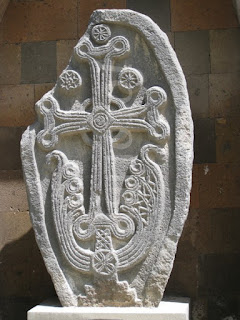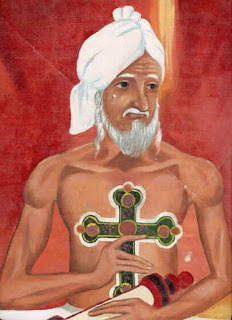For this installment in my series "A Brief History of Visual Contextualization in India," I'll be discussing India's first Christian community, the Saint Thomas Christians (or "Nasrani"). Saint Thomas Christians traditionally live in the southwestern coastal state of Kerala and descend from a union of the local Indian population with a Jewish diaspora community, who had become Christians in the earliest days of the faith. The Saint Thomas denominations use a Syriac liturgy in their church services and trace their spiritual heritage back to the assumed arrival of the Apostle Thomas ("Doubting Thomas") in southern India in 52 A.D. In the third century, Nestorian Christian missionaries from the Church of the East in Persia began to settle in Kerala and organize the churches there according to their beliefs and liturgy. Later in 1665, due to religious pressure from Portugese Catholics, the Saint Thomas Christians began to split into various factions along Catholic/Nestorian lines. Today, this schism has resulted in several different Saint Thomas denominations, including Nestorian, Catholic, Orthodox, and even (since 1961) Evangelical!
The cross has been an elemental symbol for Saint Thomas Christians for centuries, and in India it represents a fusion of Syriac Christian and Hindu concepts. The symbolism of the cross gained prominence in the Syriac tradition earlier than in the other church movements, where it was used to decorate Christian tombs in the Near East as early as 250 A.D. Prior to the arrival of the Portugese in 1498, there were no anthropomorphic representations in Saint Thomas Churches.
 |
| St. Thomas Cross from Chennai, India |
An early example of the Christian cross in India is a granite cross from the Saint Thomas Mount in Chennai, India, where the martyrdom of St. Thomas is said to have occurred. This Saint Thomas Cross (or Nasrani Cross) was discovered in 1547 by the Portugese as they dug the foundation of a new chapel at an older church site. The Portugese were unable to read its inscription, and assumed that the cross came from the time of the apostle's martyrdom.
This cross has since been dated to the eighth century, and the language of its inscription has been identified as middle Persian. It reads: "My Lord Christ, have mercy upon Abias, son of Chaharbukht, the Syrian, who cut this." Alternatively, the ending phrase may also be translated as "who preserved this." M. Thomas Antony writes "CPT Winkworth’s interpretation of the inscriptions suggest that the Mount Cross was re-erected by the inscriber... That means, the cross without any inscriptions was already there, and [Abias] found it and preserved it– [he] put it up. Putting an inscription around a cross is not a meritorious act, but setting up a cross or preserving a neglected cross is definitely a meritorious act."
 |
| Makara Thoranam at Halibedu, Karnataka |
The arch over the cross, reminiscent of Buddhist or Hindu art, is called a thoran. In Hindu temples a thoran frames the depiction of a deity. In the case of this Saint Thomas cross, the thoran consists of two aquatic monsters from Hindu mythology (called makara), facing each other from atop column capitals (the same capitals can be seen in Hindu temples in Kanchipuram on the southeastern Indian coast, and also date from the eighth century). On the Saint Thomas Cross, the left makara spits water into the mouth of the makara on the right, forming an aquatic archway that symbolizes the journey of the sun through the sky.
The three-stepped base upon which some St. Thomas crosses rest represents Golgotha. Because Saint Thomas Christians lived in such close proximity to both Muslims as well as Hindus, it is possible that they decided not to depict the Trinity or saints in their churches and artwork in order to avoid confusion or offense to either group.
 |
| Sarcophagus of Archbishop Theodore, c.677-88 (marble), Byzantine School (7th century) |
 |
| Sarcophagus of Aelia Galla Placidia,(392-450). |
The flowing shapes between the cross and its base on the Saint Thomas cross have been interpreted not only as a lotus flower, but also as gushing water. Jyoti Sahi (1998: 30) writes that the water symbolism of this cross is probably linked to the waters of baptism, as well as to the water which flows beside the tree of life in the book of Revelation. The connection of water beneath the cross to the the River of Life in Revelation also reinforces the identification of the Saint Thomas Cross as a tree of life.
 |
| Khachkar, 9th century, Armenia. |
Wing-like motifs at the base of crosses appear also in Armenia during this time, on stone cross carvings called khachkars. These "wings" appear to be some kind of palm branch, tying it into the image of a tree of life as in the Syriac tradition. Here is a modern khachkar unveiled in 2009 in Poland which also shows a dove above the cross, although this is not a common motif on ancient or modern khachkars. I am going to have to do a separate post on khachkars in the future.
 |
| Nasrani Sthambam, or open air cross. |
During various church festival days and processional days, people walk around the crosses. They also burn coconut oil in small lamps as an act of reverence at the base of these large crosses, much in the same way that oil is burned at Hindu temples around stone lingams (phalluses which symbolize the Hindu deity Shiva).
 |
| Cross pedestal at Kaduthuruthy. |
The open air crosses are regarded by Saint Thomas Christians as a type of axis mundi, the connection between heaven and earth, around which all of creation turns. Prof. George Menachery writes that "like the Egyptian obelisks the cross is a ray of the sun– Horus or Christ."
In addition to the stone crosses, some Kerala churches display a flag pole topped by a cross outside the church. Again, this is similar to flag poles which are placed outside Hindu temples and a flag is hoisted on the primary feast day of the deity of the shrine. The flagstaff on the left above is at Our Lady Of Snow Church, while the closeup of the flagstaff on the right is at St Sebastian's Syro-Malabar Roman Catholic Church, both in Kerala.
These flagstaffs and open air crosses are examples of Saint Thomas Christians taking Hindu worship practices, adapting them, and then applying them to Christ.
These flagstaffs and open air crosses are examples of Saint Thomas Christians taking Hindu worship practices, adapting them, and then applying them to Christ.
 |
| Nilavilakku. |
Unlike the Hindu Nilavilakku, those of the Saint Thomas Christians is surmounted by the Nasrani Cross and dove. Many of the Saint Thomas churches also have hanging oil lamps in their naves, which are also fed by oil brought by worshippers.
 |
| Saint Thomas Christians lighting a Nilavilakku. |
Jyoti Sahi (1998: 26-27) offers some insights about the Saint Thomas Christians' use of the cross in Kerala:
I would propose that the way in which the early church in India apparently understood the cross as axial, in much the same way as the high crosses of Celtic tradition drew on pre-Christian cosmic symbolism, does provide us with an important understanding of the cross in relation to other faiths. The cross is a way of re-interpreting sacred space and of connecting the Christian community with the culture of that place. So often the cross is used by the church as a way of dividing Christians from the culture of those who are not professing the faith of the gospels– a way of setting the Christian community over and against the prevailing local cultures.
In Kerala, one feels that the cross is perceived differently, as a uniting force which helps the church to become inculturated and to root itself in the most central sympols which characterise the land. The cross is the point of connection, of discovering the origins of our experience of sacred space within the cultural memory of the past.
I would like to finish with some observations of my own. Regarding the Saint Thomas cross itself, it seems to me that it is largely an Eastern Orthodox emblem, whose symbolism has been only slightly tweaked by reinterpreting the watery forms at the bottom of the cross as a lotus, and therefore a symbol of India. However, this symbolism can be seen more clearly in the open air crosses, where the lotus is explicitly portrayed (it is also used in various architectural details inside some of the churches as well). These outdoor crosses seem to be more inherently Indian and contextualized for use by worshipers from a Hindu community, in that these crosses were not adapted from examples originating outside India.
I can't really comment on the ritual uses of the crosses within the Saint Thomas tradition, since that would require more research, and frankly I'm tapped out at this point. But that kind of information would be integral to having a more complete picture of Saint Thomas Christianity, and how the image of the cross and the gospel itself is understood within their churches, as well as by the surrounding Hindu community. This is something that I will try to explore in a future post. The gospel has to be contextualized wherever it is presented, both by comparison and by contrast. Ultimately that understanding (or lack of it) is what determines whether any particular form of contextualization is successful or not.
I can't really comment on the ritual uses of the crosses within the Saint Thomas tradition, since that would require more research, and frankly I'm tapped out at this point. But that kind of information would be integral to having a more complete picture of Saint Thomas Christianity, and how the image of the cross and the gospel itself is understood within their churches, as well as by the surrounding Hindu community. This is something that I will try to explore in a future post. The gospel has to be contextualized wherever it is presented, both by comparison and by contrast. Ultimately that understanding (or lack of it) is what determines whether any particular form of contextualization is successful or not.








nice informative blog
ReplyDeletegranites in chennai
paiters in chennai
Read with great interest your take on indigenous Christian art of India, esp. Kerala. You may be interested in referring your readers to some 500 odd photographs on the topic published in 1. The St. Thomas Christian Encyclopaedia of India, Vol. 2, 1973 Ed. Prof. George Menachery and 2. The Indian Church History Classics, Vol. 1, The Nazranies 1998, ed. Prof. George Menachery. Cf.www.indianchristianity.com or www.nazraney.com for two dozen pictures and many books and articles on this subject.
ReplyDeleteLet your good work go forward!
There is a long and well researched article on the Granite Objects of Kerala Churches in Glimpses of Nazraney Heritage, 2005, by Prof. George Menachery where the author addresses almost all questions related to these unique crosses.
ReplyDelete